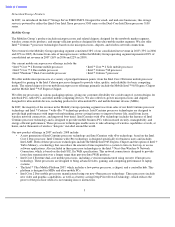Intel 2007 Annual Report Download - page 20
Download and view the complete annual report
Please find page 20 of the 2007 Intel annual report below. You can navigate through the pages in the report by either clicking on the pages listed below, or by using the keyword search tool below to find specific information within the annual report.
Table of Contents
ITEM 1A. RISK FACTORS
Fluctuations in demand for our products may harm our financial results and are difficult to forecast.
If demand for our products fluctuates, our revenue and gross margin could be harmed. Important factors that could cause
demand for our products to fluctuate include:
If product demand decreases, our manufacturing or assembly and test capacity could be underutilized, and we may be required
to record an impairment on our long-lived assets including facilities and equipment, as well as intangible assets, which would
increase our expenses. In addition, factory-planning decisions may shorten the useful lives of long-lived assets, including
facilities and equipment, and cause us to accelerate depreciation. In the long term, if product demand increases, we may not be
able to add manufacturing or assembly and test capacity fast enough to meet market demand. These changes in demand for our
products, and changes in our customers’ product needs, could have a variety of negative effects on our competitive position
and our financial results, and, in certain cases, may reduce our revenue, increase our costs, lower our gross margin percentage,
or require us to recognize impairments of our assets. In addition, if product demand decreases or we fail to forecast demand
accurately, we could be required to write off inventory or record underutilization charges, which would have a negative impact
on our gross margin.
The semiconductor industry and our operations are characterized by a high percentage of costs that are fixed or difficult to
reduce in the short term, and by product demand that is highly variable and subject to significant downturns that may
harm our business, results of operations, and financial condition.
The semiconductor industry and our operations are characterized by high costs, such as those related to facility construction
and equipment, R&D, and employment and training of a highly skilled workforce, that are either fixed or difficult to reduce in
the short term. At the same time, demand for our products is highly variable and there have been downturns, often in
connection with maturing product cycles as well as downturns in general economic market conditions. These downturns have
been characterized by reduced product demand, manufacturing overcapacity, high inventory levels, and lower average selling
prices. The combination of these factors may cause our revenue, gross margin, cash flow, and profitability to vary significantly
in both the short and long term.
We operate in intensely competitive industries, and our failure to respond quickly to technological developments and
incorporate new features into our products could harm our ability to compete.
We operate in intensely competitive industries that experience rapid technological developments, changes in industry
standards, changes in customer requirements, and frequent new product introductions and improvements. If we are unable to
respond quickly and successfully to these developments, we may lose our competitive position, and our products or
technologies may become uncompetitive or obsolete. To compete successfully, we must maintain a successful R&D effort,
develop new products and production processes, and improve our existing products and processes at the same pace or ahead of
our competitors. We may not be able to develop and market these new products successfully, the products we invest in and
develop may not be well received by customers, and products developed and new technologies offered by others may affect
demand for our products. These types of events could have a variety of negative effects on our competitive position and our
financial results, such as reducing our revenue, increasing our costs, lowering our gross margin percentage, and requiring us to
recognize impairments of our assets.
Fluctuations in the mix of products sold may harm our financial results.
Because of the wide price differences among mobile, desktop, and server microprocessors, the mix and types of performance
capabilities of microprocessors sold affect the average selling price of our products and have a substantial impact on our
revenue and gross margin. Our financial results also depend in part on the mix of other products that we sell, such as chipsets,
flash memory, and other semiconductor products. In addition, more recently introduced products tend to have higher
associated costs because of initial overall development and production ramp. Fluctuations in the mix and types of our products
may also affect the extent to which we are able to recover the fixed costs and investments associated with a particular product,
and as a result can harm our financial results.
15
• changes in business and economic conditions, including a downturn in the semiconductor industry and/or the overall
economy;
•
changes in consumer confidence caused by changes in market conditions, including changes in the credit market;
• competitive pressures, including pricing pressures, from companies that have competing products, chip architectures,
manufacturing technologies, and marketing programs;
•
changes in customer product needs;
•
changes in the level of customers
’
components inventory;
•
strategic actions taken by our competitors; and
•
market acceptance of our products.
























